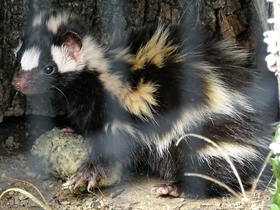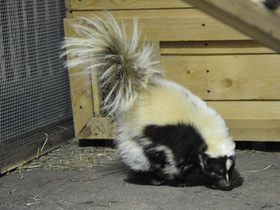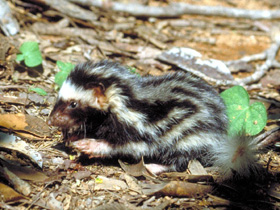The family Mephitidae
Mephitidae is a family of mammals comprising the skunks and stink badgers. They are noted for the great development of their anal scent glands, which they use to deter predators. Skunks were formerly classified as a subfamily of the Mustelidae (the weasel family); however, in the 1990s, genetic evidence caused skunks to be treated as a separate family. Similarly, the stink badgers had been classified with badgers, but genetic evidence shows they share a more recent common ancestor with skunks, so they are now included in the skunk family. A 2017 study using retroposon markers indicated that they are most closely related to the Ailuridae (red pandas and allies) and Procyonidae (raccoons and allies).
There are twelve extant species of mephitids in four genera: Conepatus (hog-nosed skunks, four species); Mephitis (the hooded and striped skunks, two species); Mydaus (stink badgers, two species); and Spilogale (spotted skunks, four species). The two stink badgers in the genus Mydaus inhabit Indonesia, Brunei, Malaysia and the Philippines; the other members of the family inhabit the Americas, ranging from Canada to central South America. All other mephitids are extinct, known through fossils, including those from Eurasia.
In taxonomic order, the living species of Mephitidae are:
Genres and species Previously they were considered a subfamily of the mustelids, until a DNA study (Dragoo and Honeycutt, 1997, Journal of Mammalogy, 78(2): 426-443) led to their reorganization into said family. According to Mammal Species of the World, the family currently contains four genera and twelve species:
- Genus Conepatus:
- Conepatus chinga, Molina's hog-nosed skunk.
- Conepatus humboldtii, Patagonian hog-nosed skunk.
- Conepatus leuconotus, Eastern hog-nosed skunk.
- Conepatus semistriatus - Amazonian hog-nosed skunk.
- Genus Mephitis (type):
- Mephitis macroura, hooded skunk.
- Mephitis mephitis, common or striped skunk.
- Genus Mydaus:
- Mydaus javanensis, Malayan skunk badger or teledu.
- Mydaus marchei, Palawan stink badger.
- Genus Spilogale:
- Spilogale angustifrons, common spotted skunk.
- Spilogale gracilis, western spotted skunk.
- Spilogale putorius, eastern spotted skunk.
Spilogale pygmaea, pygmy spotted skunk. Additionally, the following fossil genera are known:
- Brachyopsigale † Hibbard, 1954;
- Brachyprotoma † Brown, 1908;
- Buisnictis4 † Hibbard, 1950;
- Martinogale5 † Hall, 1930;
- Mesomephitis † Petter, 1967;
- Miomephitis † Dehm, 1950;
- Nannomephitis † Kretzoi, 1952;
- Osmotherium † Cope, 1896;
- Palaeomephitis † Jäger, 1839;
- Plesiomeles † Viret & Crusafont, 1955;
- Pliogale † Hall, 1930;
- Promephitis6 † Gaudry, 1861".
Origin and peculiarities
Mephitidae are a family of omnivorous mammals known as skunks, skunks, mapurites, skunks, skunks, epates or chingues.
Until recently, skunks were classified as a subfamily of the Mephitinae, but molecular research has given them a separate family.
Mephitidae are easily recognisable by their distinctive colouration, which consists of white stripes or spots on a black background; these bright patterns serve as a warning to potential predators. The fact is that all animals in this family have anal scent glands, which secrete a pungent substance with a persistent foul odour, and skunks are capable of spraying this secret from a distance of up to 6 metres.
Skunks do not usually try to hide from their enemies. Instead, the beast first raises its fluffy tail and occasionally stomps its paws on the ground. If the warning is of no use, the skunk turns its back to its adversary and "shoots" an oily, yellowish liquid, usually aimed at its eyes. If it comes into contact with his eyes, this liquid causes a stinging sensation and even temporary blindness. But skunks have a limited supply in their glands, which only lasts for 5 or 6 "charges", after which they need about 10 days to recover. Therefore, skunks are reluctant to use up their "charges", preferring to scare off potential predators with their contrasting colouring and threatening postures.
Skunks are robust, with a fluffy tail and short limbs with powerful digging claws.
Habitat
Mephitrichids are found almost exclusively in the New World and inhabit a wide variety of landscapes, including forests, grassy plains, farmland and uplands. These small animals are nocturnal and often dig their own burrows or occupy the burrows of other animals.
Nutrition and reproduction
Mephitrichids are omnivorous predators: they feed on plants, worms, insects and other invertebrates, as well as small vertebrates: snakes, birds and their eggs, rodents. In the northern parts of their range, skunks accumulate fat reserves and become inactive in winter and do not leave their shelters, coming out to feed only in warmer weather.
Mephitrichids spend the winter in permanent burrows in groups consisting of a male and several females (up to 12); during the rest of the year they are mostly solitary, although they do not terrorise or mark the limits of their territory.
Mephitids have a good sense of smell and hearing, but poor eyesight (they cannot distinguish objects more than 3 m away). Their litter contains between 2 and 10 young, which are born blind and naked, but with developed scent glands. During the first week of life they are completely defenceless and dependent on the mother, becoming independent after two months. Males do not participate in the care of their young and may even kill them.
Genera and species
Previously considered a subfamily of the humpbacks until DNA research (Dragoo and Honeycutt, 1997, Journal of Mammalology, 78(2): 426-443) led to their reorganisation into a family. According to Mammal Species of the World, the family currently comprises four genera and twelve species:
- Conepatus chinga, chingue or skunk.
- Conepatus humboldtii, Patagonian skunk.
- Conepatus leuconotus, the eastern pig-nosed skunk.
- Conepatus semistriatus, the Amazonian skunk.
- Mephitis macroura, the hooded skunk.
- Mephitis mephitis - common or striped skunk.
- Mydaus javanensis, the Malayan badger or teledu skunk.
- Mydaus marchei, Palawan skunk badger.
- Spilogale angustifrons, the common spotted skunk.
- Spilogale gracilis, western spotted skunk.
- Spilogale putorius, eastern spotted skunk.
- Spilogale pygmaea, dwarf spotted skunk.
In addition, the following fossil genera are known:
- Brachyopsigale † Hibbard, 1954;
- Brachyprotoma † Brown, 1908;
- Buisnictis4 † Hibbard, 1950;
- Martinogale5 † Hall, 1930;
- Mesomephitis † Petter, 1967;
- Миомефит † Dehm, 1950;
- Nannomephitis † Kretzoi, 1952;
- Osmotherium † Cope, 1896;
- Palaeomephitis † Jäger, 1839;
- Plesiomeles † Viret & Crusafont, 1955;
- Pliogale † Hall, 1930;
- Promephitis6 † Gaudry, 1861.


















































